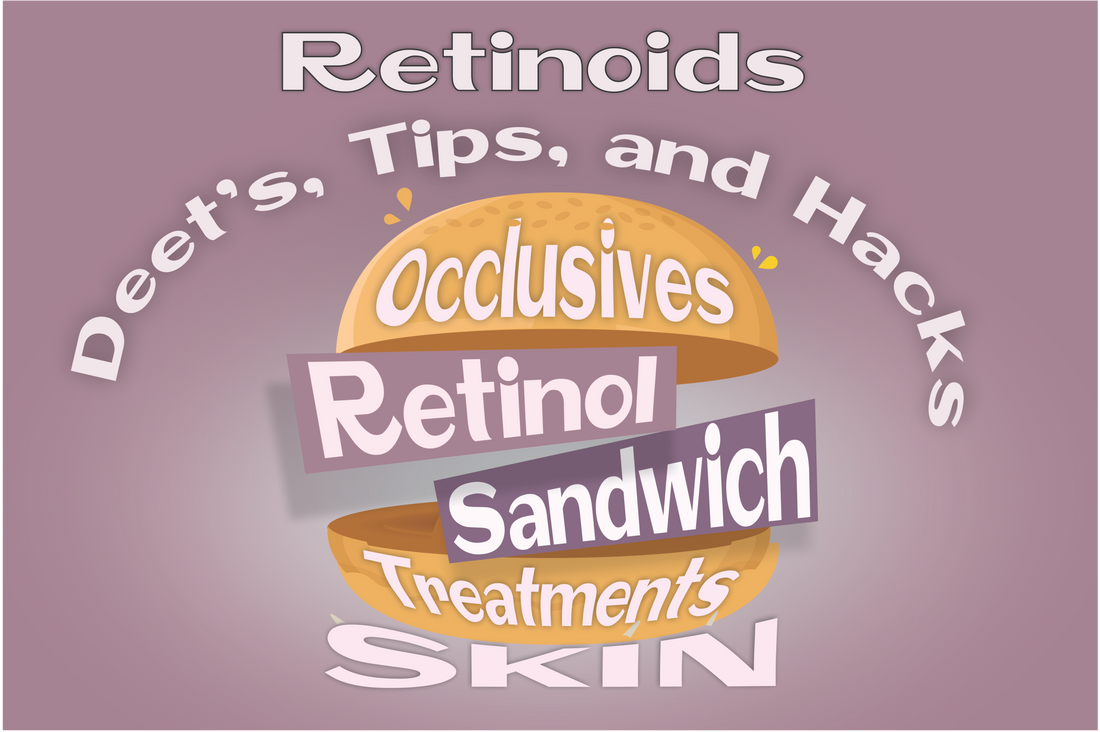
Unlock the power of retinoids for skin care
If you're dedicated to minimizing the signs of aging, incorporating retinoids into your skincare regimen is crucial. Known as one of the "big 4" skincare essentials, retinoids offer transformative benefits for the skin. Understanding how to use retinoids effectively starts with tuning into your skin's specific needs. Here's a breakdown of how retinoids work and some tips for making the most out of them.
How Retinoids Work
Retinoids operate by binding to retinoic acid receptors (RARs) within the nucleus of skin cells. This binding alters gene expression, which in turn boosts collagen production, reduces collagen breakdown, and speeds up cell turnover. These effects help improve skin texture, diminish acne, and promote a youthful appearance.
The Five Main Types of Topical Retinoids (Citation below this section)
Non-synthetic Forms:
- Retinol (Vitamin A1): Available over the counter, retinol converts into retinoic acid in a two-step process within the skin.
- Retinaldehyde: This over-the-counter option converts into retinoic acid through a single step, directly influencing RARs more effectively.
- Tretinoin (Retinoic Acid): As the direct metabolite of retinol affecting all three RAR types, tretinoin can be up to 20 times more effective than retinol and is prescription-only.
Synthetic Forms:
- Adapalene: Known for its stability and less irritating nature, adapalene selectively targets specific RARs. It is available both over the counter and by prescription.
- Tazarotene: This prodrug converts to its active form in the skin, targeting specific RARs to treat psoriasis, acne, and photoaging. Its unique chemistry enhances its specificity and effectiveness.
Feeling Nerdy?
One notable article that discusses different forms of retinol and their interactions with retinoic acid receptors (RARs) is titled "Retinoic acid and retinoic acid receptors in development" by HM Sucov and RM Evans, published in Molecular Neurobiology in 1995. This article explores how retinoids function by interacting with high-affinity receptors, detailing the complex role of retinoid receptors in a variety of tissue types. It provides insights into the different retinoid receptor genes that have emerged, emphasizing the pivotal role these interactions play in developmental processes. You can access the article here.
The rest of this blog is citation-less because I am gleaning from personal experience and/or accumulated knowledge. Please feel free to post any supportive or contradictory information below and we can discuss it further!
Why Prescription Retinoids Are More Effective and other questions.
Imagine your skin as a bakery with three specialized chefs — each responsible for creating pastries, bread, or pasta. In this analogy, the chefs represent the alpha, beta, and gamma RARs, while the products they make symbolize various cellular activities like cell proliferation and differentiation.
- Retinol is like raw wheat, undergoing several steps before it becomes usable.
- Retinaldehyde is similar to wheat that has been harvested, conditioned, and milled, ready for quicker use.
- Retinoic Acid (tretinoin) is akin to pre-made flour, directly usable and highly efficient, greatly enhancing the bakery's output.
It's all about efficiency. Skipping 2 biological processes makes the effects far more direct. Isn't chemistry wonderful?
How do retinoids help with acne?
Why is tretinoin only available by prescription here but I can go to Mexico and get some at the drug store?
We do it for the babies! Say what you want about the FDA but in some areas, they do apply an abundance of caution to protect us. Retinoic acid is directly involved in the formation of the spine, nervous system, and other crucial elements of a developing fetus. There is some doubt that topical application has any negative side effects (obviously the conclusion that the Mexican FDA equivalent came to) on a developing fetus but there is no doubt, not even a shadow of one, that the oral drug, isotretinoin, that commonly goes by the name of Accutane, does.
It seems like such a hassle to go to the derm just to spend more $ on some of the prescription stuff. Is it really worth it?
It may require a special trip to the derm, yes. It may cost more than what you can get over the counter, yes. Is it worth it? ABSOLUTELY YES! If your skin can tolerate tretinoin, even if only a couple nights a week, you will definitely see results much quicker. Truly there is more bang for your buck.
The caveat:
The direct application of tretinoin (retinoic acid) can lead to increased skin sensitivity and barrier disruption due to its potency and immediate effect on the skin's biochemistry. Here is a list of hacks I employ personally to keep these in check.
Tretinoin Hacks to Mitigate Side Effects
Most of these hacks can be used for Over-the-counter retinol products but I am focusing on the prescription version, Tretinoin.
- Start Low and Slow: Start out with the .025% tretinoin and only increase the dose when your skin can tolerate nearly daily application without adverse effects. For me, it took around 5 years to move up to the .05% and another 10 or so to move up to .1% so I mean it when I say be patient. You are still receiving many more benefits from the .025% tretinoin over store bought Retinol of any percentage.
If you have sensitive skin, you may want to give your skin a 6-month adjustment run with an over-the-counter product.
Apply Conservatively:
- Everyone talks about the "pea-sized" amount. I've found that to be too much. Instead, try shearing off a "flea-sized" whisper of product onto each fingertip on one hand. (except your thumbs obviously) then press your fingertips together in prayer position so that you have a trace amount of product on the tips of 8 fingers. Then lightly tap around your face. Begin with your oiliest areas first as you will unload the most product with your first few taps and save your eye area for last.
Don't avoid your eye area:
- The eye area is one of the places we need the benefits from this magical stuff the most but less is more! Saving your periorbital region for last ensures that you aren't tapping too much product onto this delicate skin. Do avoid your tear ducts and lash line but lids and bags will benefit from the tiniest amount.
Dilute:
- Blend a white rice-sized amount of tretinoin or retinol in with your favorite serum to dilute it. Make sure that the products you choose to use on these nights are without exfoliating acids. Look for serums that contain ingredients like ceramides, hyaluronic acid, and niacinamide. Of course, illumenase has you covered here.
If you are experiencing immediate sensitivity:
- If you have an immediate sensation of any kind when applying your retinoid, then you may have compromised barrier function. Rinse it off and use a serum like illumnease with an occlusive moisturizer on top of it. The next morning, skip the wash and just rinse. Follow this routine for a couple days and then try reintroducing your retinoid.
Follow a skin-cycle:
- Give yourself a tailored schedule to optimize all of your efforts. Learn about skin-cycling here.
Consider Short Contact Therapy:
- For potent forms like tretinoin, consider applying it as a mask for a few hours before rinsing it off, followed by moisturizer. Note: This method will not work for Retinol or Retinaldehyde.
Retinol Sandwich: My personal favorite.
- Apply a non-exfoliating, anti-inflammatory treatment serum with ceramides and hyaluronic acid like illumenase first, followed by your retinol Then use an occlusive product such as Aquaphor, shea butter, or jojoba oil on top of it all to enhance your skin's barrier function.
Take Breaks:
- If your planning exposure to intense sun or will be undergoing skin treatments like laser or waxing appointments, pause retinoid use for about 5-14 days beforehand. Personally, as a fair-skinned person living in the south, I will sometimes take a week or 2 off each of the summer months. (which in Georgia is the middle of April to the 2nd week of October) Check your UV index where you live
Always wear sunscreen.
- This goes without saying but I will say it anyway. Try not to apply your sunscreen directly to your skin without first putting down an anti-oxidative, barrier enhancing product like illumenase, especially if you have a propensity for skin sensitivity.
Skip over your sensitive areas from time to time.
- It is totally ok to avoid your most sensitive areas on occasion. Wait until the chapped feeling diminishes then go for it again.
Don't forget your body:
- Your skin can benefit head to toe from your retinoid therapy. However, it is not recommended to put tretinoin on more than one area of your body at a time. Instead, pick up a body moisturizer like Gold Bond that has the otc version of retinol in it.
What is next?
Retinoids have been an anti-aging staple for decades now, but I have a sneaking suspicion (and possibly some insider information) that you will be hearing about peptide replacements in the coming months. I am very excited to see what is next.
Conclusion
Do not be discouraged by the initial side effects of retinoids. Patience is key, and the long-term benefits, including reduced acne, even skin tone, and diminished fine lines, and a reduction in sun damage are well worth the commitment. Remember, your future self from this universe will thank you for your perseverance.
Now please enjoy a quality day ahead!
MBM

